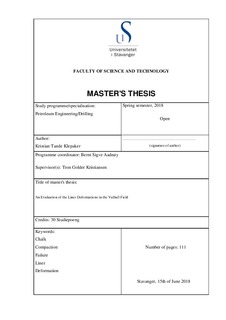| dc.contributor.advisor | Aadnøy, Bernt Sigve | |
| dc.contributor.author | Klepaker, Kristian Tande | |
| dc.date.accessioned | 2018-10-19T09:32:29Z | |
| dc.date.available | 2018-10-19T09:32:29Z | |
| dc.date.issued | 2018-06-15 | |
| dc.identifier.uri | http://hdl.handle.net/11250/2568807 | |
| dc.description | Master's thesis in Petroleum Engineering | nb_NO |
| dc.description.abstract | Valhall is one of the giant, high porosity chalk reservoir in the southern part of the Norwegian Continental Shelf. The field has been in production since 1982 with pressure depletion and reservoir compaction as main drive mechanisms. Already since pre-production well testing and throughout the its lifetime, challenges involving well failure both in the overburden and reservoir has been encountered. This has led to several re-developed well designs.
The main purpose of this Thesis is to give an extensive evaluation of the liner deformation problems located in the reservoir area. Casing and liner collapse has been a well-known problem on the Valhall field for a long time. The shear failure problems in the overburden has been assessed, and this Thesis only focuses on deformation of production liners in the reservoir section.
To obtain the data presented in this study, more than 2 000 pages of well history for both abandoned and producing wells on Valhall has been explored. All the wells showing clear indication of deformation encounter an obstruction, restriction or an unpassable point downhole, have been recorded. From these wells a collection of reservoir, liner and wellbore data have been conducted. The data has been analysed by cross plotting to investigate any correlations. In addition, presentation of the vast amount of data has been shown in Tables.
Examination shows that high angle wells in high porosity zones have failed with link to chalk influx. Due to pressure depletion and subsequently substantial compaction, stress re-distributions in the weak high porosity chalk formation has led to severe problems solids production and fault re-activation. Excessive chalk influx resulting in large cavities around the wellbore induces a non-uniform load on the liner due to loss of lateral restrain. This effect has ultimately led to liner buckling in low angle wells and collapse in high angle wells.
The implementation of heavy wall liners in 1994, was a great success. However, this study shows that more than 21% of these have clear indications of collapse. This suggest a dynamic load not anticipated. The compacting overburden collapse and hits the liner and the impact of the forces is released in a matter of seconds. Caliper logs should be conducted to either confirm or deny the theory of deformation in the heavy wall liners. | nb_NO |
| dc.language.iso | eng | nb_NO |
| dc.publisher | University of Stavanger, Norway | nb_NO |
| dc.relation.ispartofseries | Masteroppgave/UIS-TN-IEP/2018; | |
| dc.rights | Navngivelse 4.0 Internasjonal | * |
| dc.rights | Attribution-NoDerivatives 4.0 Internasjonal | * |
| dc.rights.uri | http://creativecommons.org/licenses/by-nd/4.0/deed.no | * |
| dc.subject | petroleumsteknologi | nb_NO |
| dc.subject | petroleum engineering | nb_NO |
| dc.title | An Evaluation of Liner Deformation in the Valhall Field | nb_NO |
| dc.type | Master thesis | nb_NO |
| dc.subject.nsi | VDP::Teknologi: 500::Berg‑ og petroleumsfag: 510::Petroleumsteknologi: 512 | nb_NO |

